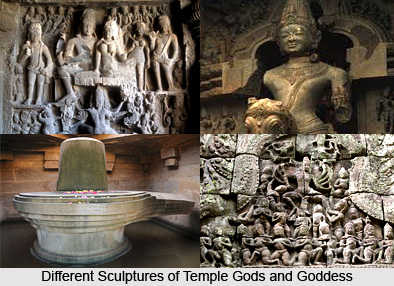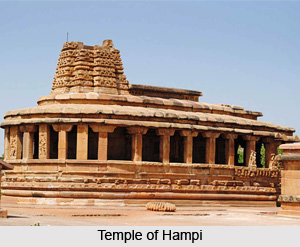 The temple deity sculptures under the Western Chalukya kings were a thing to reckon with. Being the followers of Hinduism most of the mother goddesses which were etched out of stone belonged to this sect. According to historical evidences the Western Chalukyan kings were Shaivas and hence most of there temples were dedicated to Lord Shiva. However they practised religious tolerance. Therefore temples dedicated to Lord Vishnu and Jain Tirthankaras were also built. However, almost all these temples shared the same features of Western Chalukyan sculptures but it is also true that the difference in religious beliefs left behind minute differences in the temple architectures.
The temple deity sculptures under the Western Chalukya kings were a thing to reckon with. Being the followers of Hinduism most of the mother goddesses which were etched out of stone belonged to this sect. According to historical evidences the Western Chalukyan kings were Shaivas and hence most of there temples were dedicated to Lord Shiva. However they practised religious tolerance. Therefore temples dedicated to Lord Vishnu and Jain Tirthankaras were also built. However, almost all these temples shared the same features of Western Chalukyan sculptures but it is also true that the difference in religious beliefs left behind minute differences in the temple architectures.
The deity of the goddess is placed in `garbhagriha.` Besides the statue of Lord Shiva, that of Gaja Lakshmi is also found on the lentils. In some of the Western Chalukya temples images of Lord Vishnu seated on his `vahan` Garuda or Garuda are also recurring motifs. These images were primarily found in Vaishnava temples. However the sculpture of Gaja Lakshmi is found in all kinds of temples on the entrance of the manadapa. The joist on the doorway to the `garbhagriha` consists of the Shiva linga or Lord Ganesha if these are Shaiva temples. In case of Jain temples the idols of Jain Tirthankaras occupy the sanctum.
 The nooks at the base of the shikhara are filled with the sculpture of the god to whom the temple is dedicated. Besides the sculpted idols of the `trimurti`, that is, Brahma, Vishnu and Shiva are also part of the shikhara sculpture. Needless to say the sculptures of the Western Chalukya temples are centered on the Hindu religion. Whether it is the gopuram, the shikhara or the outer walls the deities and other mythological characters had been carefully etched out on stone. Hence almost all the Western Chalukya temples have the sculptures of Lord Ganesha, Lord Kartikeya and other forms of Shakti are represented here. At the foot of these rock cut temples river goddesses, such as, Ganga and Yamuna have been etched out.
The nooks at the base of the shikhara are filled with the sculpture of the god to whom the temple is dedicated. Besides the sculpted idols of the `trimurti`, that is, Brahma, Vishnu and Shiva are also part of the shikhara sculpture. Needless to say the sculptures of the Western Chalukya temples are centered on the Hindu religion. Whether it is the gopuram, the shikhara or the outer walls the deities and other mythological characters had been carefully etched out on stone. Hence almost all the Western Chalukya temples have the sculptures of Lord Ganesha, Lord Kartikeya and other forms of Shakti are represented here. At the foot of these rock cut temples river goddesses, such as, Ganga and Yamuna have been etched out.
The temple deity sculpture of the Western Chalukya broke away from the conventional stiff form. The temple figurines in this particular era had spontaneity and were more informal. The pose of each deity depended on the religion or belief she represented. Instead of being well defined these sculptures had a realistic feel. The free flowing limbs, relaxed poses and the outlined drapery of the temple deities were exemplarily portrayed on stone.
One of the best instances of temple deity sculptures under the Western Chalukya is to be found in the Saraswati Temple in Gadag city.



















